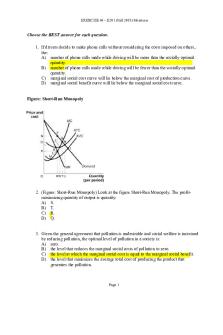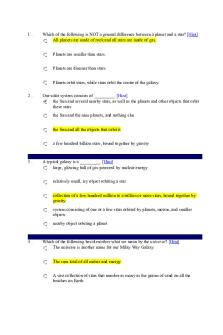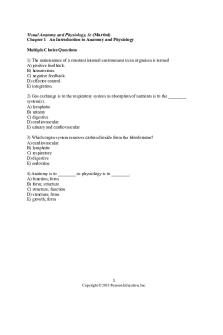Exercise 1 Questions and Answers PDF

| Title | Exercise 1 Questions and Answers |
|---|---|
| Course | Intro To Microeconomics |
| Institution | Indiana University - Purdue University Indianapolis |
| Pages | 4 |
| File Size | 131.5 KB |
| File Type | |
| Total Downloads | 316 |
| Total Views | 865 |
Summary
Exercise E201 (Morrison) Fall 2018 Choose the best answer for each question. Your answers are due the start of class on 1. If an economy is producing inside its Production Possibilities Frontier then, a. it is using its resources b. it is using its resources c. such a level of production is d. such ...
Description
Exercise#1–E201(Morrison)Fall2018 Choosethebestanswerforeachquestion.Youranswersareduebythestartofclasson 1. IfaneconomyisproducinginsideitsProductionPossibilitiesFrontierthen, a. itisusingitsresourcesefficiently; b. itisusingitsresourcesinefficiently; c. suchalevelofproductionisunattainable; d. suchalevelofproductionwouldonlybeattainablethroughtrade. 2. Themarginalbenefityoureceivefromagoodisthemaximumamountyouarewillingtopayfor, a. allofthegoodthatyouconsume; b. onemoreunitofthegood; c. alloftheunitsofthegoodyouconsumedividedbythenumberofunitsyoupurchased; d. onemoreunitofthegooddividedbythenumberofunitsyoupurchased. 3. Inoneday,Stancaneitherplow10acresorplant20acres.Inoneday,Chriscaneitherplow15acresor plant15acres.StanandChriscan, a. gainfromexchangeifStanspecializesinplantingandChrisinplowing; b. gainfromexchangeifStanspecializesinplowingandChrisinplanting; c. exchange,butonlyStanwillgainfromtheexchange; d. exchange,butonlyChriswillgainfromtheexchange. 4. ScarcityinEconomicsmeansthat: a. Wedonothavesufficientresourcestoproduceallofthegoodsandservicesthatwewant; b. Thewantsofpeoplearelimited; c. Theremustbepoorpeopleinrichcountries; d. Shortagesexistinnearlyallmarkets.
5. Whenachefpreparesadinnerforacustomer,whichofthefollowingisphysicalcapital? a. Thechef; b. Theoven; c. Thefoodingredients; d. Thechef’strainingandexperience.
6. Opportunitycostis: a. Abouthalfthemonetarycostofaproduct; b. Thedollarpaymentforaproduct; c. Thebenefitderivedfromaproduct; d. Thevalueofthebestalternativeforgoneinmakinganychoice.
7. Margospends$10,000ononeyear’scollegetuitionandbooks.Theopportunitycostofspendingone yearincollegeforMargois: a. $10,000; b. Whatevershewouldhavepurchasedwiththe$10,000instead; c. Whatevershewouldhaveearnedhadshenotbeenincollege; d. Whatevershewouldhavepurchasedwiththe$10,000pluswhatevershewouldhaveearnedhad shenotbeenincollege.
8. Whichofthefollowingisthebestexampleofmakingachoiceatthemargin? a. Buyinganewcar; b. Quittingyourjob; c. Drinkinganothercupofcoffee; d. Attendingcollege.
9. ThemarginalbenefitJuliereceivesfromconsumingathirdchocolatebaris, a. themaximumamountsheiswillingtopayforonlythethirdchocolatebar; b. themaximumamountsheiswillingtopayforallthreechocolatebars; c. themaximumamountsheiswillingtopayforallthreechocolatebarsdividedbythree; d. themaximumamountsheiswillingtopayforthethirdchocolatebar,minustheamountshe wouldaccepttosellthatchocolatebar. 10. Economistsusethetermequilibriumtodescribethesituationinwhich: a. Individualsareequal; b. Noindividualwouldbebetterofftakingadifferentaction; c. Noindividualhastheincentivetochangehisorherbehavior d. Noindividualwouldbebetterofftakingadifferentactionornoindividualhastheincentiveto changehisorherbehavior. 11. Aneconomicmodel: a. Isusefulforexplainingpasteconomicconditionsbutnotforpredicting; b. Oftenleadstofaultyconclusionsbecauseoftheassumptionthateverythingelseremains unchanged; c. Neverallowsanythingtochangeintheeconomicsituationthatisbeingdescribed; d. Isasimplifiedversionofrealityusedtounderstandreal‐worldeconomicconditions. 12. ThemayorofGothamcity,worriedaboutapotentialepidemicofdeadlyinfluenzathiswinter,asksan economicadviseraseriesofquestions.Whichthefollowingquestionsisnormative? a. HowmuchvaccinewillbeinstockinthecitybytheendofNovember? b. Ifthecitycharges$25pershot,howmanypeoplewillpaytogettheshot? c. Ifthereisashortageofvaccineinthecity,whomshouldwevaccinatefirst—theelderlyorthe veryyoung?(Assumethatapersonfromonegrouphasanequallikelihoodofdyingfrom influenzaasapersonfromtheothergroup.) d. Ifweoffertopay10%moreperdosetothepharmaceuticalcompaniesprovidingthevaccines, willtheyprovideadditionaldoses? 13. TheDemocraticRepublicoftheCongo(DRC)istheworld’slargestsourceofColtan(usedinallsmart phones)andalargesourceofcopper.Thetablebelowshowsdifferentcombinationsofthosetwogoods thatcanbeproducedbyDRC.(Notethatthetableshowsaconstanttrade‐off). Coltan Copper 16,000tons 0 12,000tons 50,000tons 8,000tons 100,000tons 4,000tons 150,000tons 0 200,000tons WhatistheopportunitycostofproducingeachtonofColtan? a. 200.0tonsofcopper b. 12.5tonsofcopper c. 16.0tonsofcopper d. 125.0tonsofcopper
THEFOLLOWINGDESCRIPTIONRELATESTOBOTHQUESTIONS14‐16:Atlantisisasmall,isolatedisland intheSouthAtlantic.Theinhabitantsgrowpotatoesandcatchfish.Thefollowingtableshowsthe maximumannualoutputcombinationsofpotatoesandfishthatcanbeproduced.Obviously,giventheir limitedresourcesandavailabletechnology,astheyusemoreoftheirresourcesforpotatoproduction, therearefewerresourcesavailableforcatchingfish. MaximumAnnualOutput QuantityofFish(pounds) QuantityofPotatoes(pounds) Possibilities A 1,000 0 B 800 300 C 600 500 D 400 600 E 200 650 F 0 675 14. Whatistheopportunitycostofincreasingtheannualoutputofpotatoesfrom600to800pounds? a. 1.481poundsoffish b. 0.675poundsoffish c. 1.5poundsoffish d. 1poundoffish
15. Whatistheopportunitycostofincreasingtheannualoutputofpotatoesfrom200to400pounds? a. 1poundoffish b. 0.25poundsoffish c. 4poundsoffish d. 10poundsoffish
16. CanAtlantisproduce500poundsofpotatoesand500poundsoffish? a. No,theydonothavetheresourcestoproducethatmuch. b. Yes,butitwouldbeinefficienttodoso. c. Yes,buttheywouldhavetousealloftheirresourcestodoso. d. No,theycanonlyproduceonegoodortheother,notboth.
17. WhichofthefollowingisNOTrepresentedinthecircular‐flowdiagram? a. Theflowofmoneyandofgoodsandservicesintheeconomy. b. Theflowofmoneyfromhouseholdstofirmswhenthehouseholdpurchasesgoodsandservices. c. Theflowofmoneyfromhouseholdstofirmswhenthehouseholdsellstheirlabor. d. Theflowofmoneyfromfirmstohouseholdswhenthehouseholdsellstheirlabor.
18. Anormativestatementis, a. Aboutwhatoughttobe; b. Aboutincrementalchanges; c. Isalwaystrue; d. Issomethingthatcanbetestedtoseeifitistrue.
19. SpecializationandtradeshouldleadtoallofthefollowingEXCEPT: a. Individualslearningspecificskillsandearningasalary; b. Adecreaseintotaleconomicoutput; c. Higherlivingstandards; d. Theexchangeofgoodsandservicesinmarkets.
20. ThetablebelowshowsthetotaloutputoftheU.S.A.andChina,iftheyspecializeinoneparticularoutput foranentireday.Whatcanwesayabouttradebetweenthesetwocountries? a. BoththeU.S.A.andChinacanbebetteroffiftheU.S.A.specializesinsoybeansandChinainsmart phones,andtheytrade; b. SincetheU.S.A.hasanabsoluteadvantageinproducingbothsoybeansandsmartphones,China wouldbeengaginginunfairtradeandtheU.S.A.willbeworseoffthaniftheydidnottrade; c. BoththeU.S.A.andChinacanbebetteroffiftheU.S.A.specializesinsmartphonesandChinain soybeans,andtheytrade; d. TheU.S.A.wouldnotbewillingtotradewithChinabecausetheU.S.A.hasacomparative advantageinproducingbothsoybeansandsmartphones.
U.S.A. China
Outputifonlysoybeansare produced 1,000poundsofsoybeans 800poundsofsoybeans
Outputifonlysmartphones areproduced 5,000Smartphones 4,800Smartphones...
Similar Free PDFs

Exercise 1 Questions and Answers
- 4 Pages

Exercise 4 Questions and Answers
- 8 Pages

Answers - Listening Exercise # 1
- 1 Pages

Midterm 1, questions and answers
- 8 Pages

Chapter 1 Exercise Questions
- 6 Pages

1 2020, questions and answers
- 12 Pages

Quiz 1 questions and answers
- 4 Pages

Midterm 1, questions and answers
- 14 Pages

Quiz 1 - questions and answers
- 5 Pages

Exercise Set 1 - Questions
- 1 Pages

TEST 1, questions and answers
- 30 Pages

Quiz 1 Questions and Answers
- 2 Pages

Week 1 Questions and Answers
- 2 Pages

Quiz 1 - questions and answers
- 21 Pages
Popular Institutions
- Tinajero National High School - Annex
- Politeknik Caltex Riau
- Yokohama City University
- SGT University
- University of Al-Qadisiyah
- Divine Word College of Vigan
- Techniek College Rotterdam
- Universidade de Santiago
- Universiti Teknologi MARA Cawangan Johor Kampus Pasir Gudang
- Poltekkes Kemenkes Yogyakarta
- Baguio City National High School
- Colegio san marcos
- preparatoria uno
- Centro de Bachillerato Tecnológico Industrial y de Servicios No. 107
- Dalian Maritime University
- Quang Trung Secondary School
- Colegio Tecnológico en Informática
- Corporación Regional de Educación Superior
- Grupo CEDVA
- Dar Al Uloom University
- Centro de Estudios Preuniversitarios de la Universidad Nacional de Ingeniería
- 上智大学
- Aakash International School, Nuna Majara
- San Felipe Neri Catholic School
- Kang Chiao International School - New Taipei City
- Misamis Occidental National High School
- Institución Educativa Escuela Normal Juan Ladrilleros
- Kolehiyo ng Pantukan
- Batanes State College
- Instituto Continental
- Sekolah Menengah Kejuruan Kesehatan Kaltara (Tarakan)
- Colegio de La Inmaculada Concepcion - Cebu

